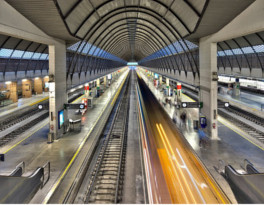HISTORY OF THE INDUSTRY
An industry over 100 years old at the service of society
1898
The first artificial cement plant was opened in Tudela Veguín (Asturias). It had a production capacity of 15,000 tonnes per year.
1925
On September 4th, 1925, in Madrid, the Association of National Cement Manufacturers was established.
1929-1939
The Economic Crisis of 1929 caused a fall in industrial production that did not recover until 1935. However, this improvement was curtailed by the outbreak of the Spanish Civil War in 1936.

1949
The research work conducted in those years led to the establishment of the Instituto Técnico de la Construcción y del Cemento (Instituto Eduardo Torroja).
1950-1959
There was rapid industrial growth during the 1950s coupled with a major transfer of the labour force from rural areas to the cities, which was conducive to a series of improvements, namely:
- Cement was transported by road rather than by rail.
- Plants were now to be found throughout the country, except for the zones where there were no raw materials.
- Cement sacks made of paper replaced fibre sacks.
1959-1970
Major economic growth took place in the 1960s, which meant a new boom for cement, because both production and consumption increased fourfold.
1973-1980
The boost in the industry had a positive effect on the development of technology at the manufacturing plants. As a result, some facilities were modernised, production capacity being increased to 33.4 million tonnes.
1983
The energy crisis in the eighties found itself having to resort to using coal again as the fuel, maximum exports being reached in 1983, more than 13 million tonnes being exported.
1985-1990
A new growth period ensured as from 1985, with constant increases in apparent consumption of around 12% per year, until the figure of 28.6 million tonnes was reached in 1990. The basic aim of investments was to raise production capacity, quality and productivity, as well as to bring about an improvement in environmental impact.

1991-2000
The largest ever consumption figures were achieved in 1992, on the occasion of Seville EXPO ‘92 and the Olympic Games in Barcelona that same year. Those figures were not exceeded until the beginning of 1998.
The most significant occurrences in the 1990s could be summarised as follows:
- The sector recovered with major growth rates.
- The industry was gradually modernised; structure costs were adapted to the market situation, with a notable increase in productivity.
- The internationalisation of the industry owing to the fact that frontiers were opened to the products and capital.
2000-2007
The Spanish cement sector is characterised by having a constantly changing market with a considerable increase in demand. As a result, production increased from 25 million tonnes in 1996 to 56 million tonnes in 2007, as Spain came to lead Europe and became fifth in the world ranking. A production record was set that has yet to be surpassed.
Present Time
- Since 2007, when cement consumption peaked in Spain and the turning point was reached with the current crisis, -which is the most sudden and prolonged crisis to be experienced by the cement industry throughout its history-, cement consumption plummeted by 80%. Therefore, our industry has had to look towards other markets and make Spain the top cement exporter in the European Union.
- Since 2012, cement consumption has stagnated in absolute values to levels similar to those of the 1960s. Furthermore, these figures amount to less than half the annual average for the past 50 years.
